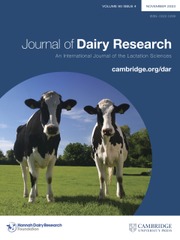No CrossRef data available.
Article contents
Enhanced milk preservation during long-distance transportation: a numerical study of immersed evaporator system
Published online by Cambridge University Press: 25 September 2025
Abstract
Exceeding 10°C during raw milk transportation leads to its degradation, making it unsuitable for consumption. Maintaining a stable low temperature is therefore crucial to preserving milk quality over long distances. Traditional insulation methods have proven inadequate, particularly under extreme climatic conditions. This study proposes a novel approach incorporating an immersed evaporator within the milk tank to significantly extend the cooling duration and ensure product safety. Using unsteady laminar flow and heat transfer simulations, we evaluated the performance of the immersed evaporator system under various operating conditions. Results demonstrate a substantial improvement in cooling efficiency compared to conventional insulation. Key findings include: (1) An immersed evaporator can extend the cooling time by up to 3 h and 19 min (a 69% improvement) compared to insulation alone (1 h and 36 min). (2) Increasing the length of the evaporator by approximately 46% further extends the cooling period by 91%, while maintaining the same temperature of 2°C in both cases. (3) Increasing the evaporator length and decreasing its temperature to 0°C further enhance cooling performance, with potential improvements of up to 137% (8 h 48 min) in cooling time. A well-designed immersed evaporator system can maintain milk temperature below 10°C for an entire day, even in harsh environments. These findings offer a promising solution for the safe and efficient transportation of milk over long distances. By integrating immersed evaporators into milk tankers, we can ensure product quality and minimize spoilage, thereby contributing to a more sustainable and reliable food supply chain.
Information
- Type
- Research Article
- Information
- Copyright
- © The Author(s), 2025. Published by Cambridge University Press on behalf of Hannah Dairy Research Foundation.

